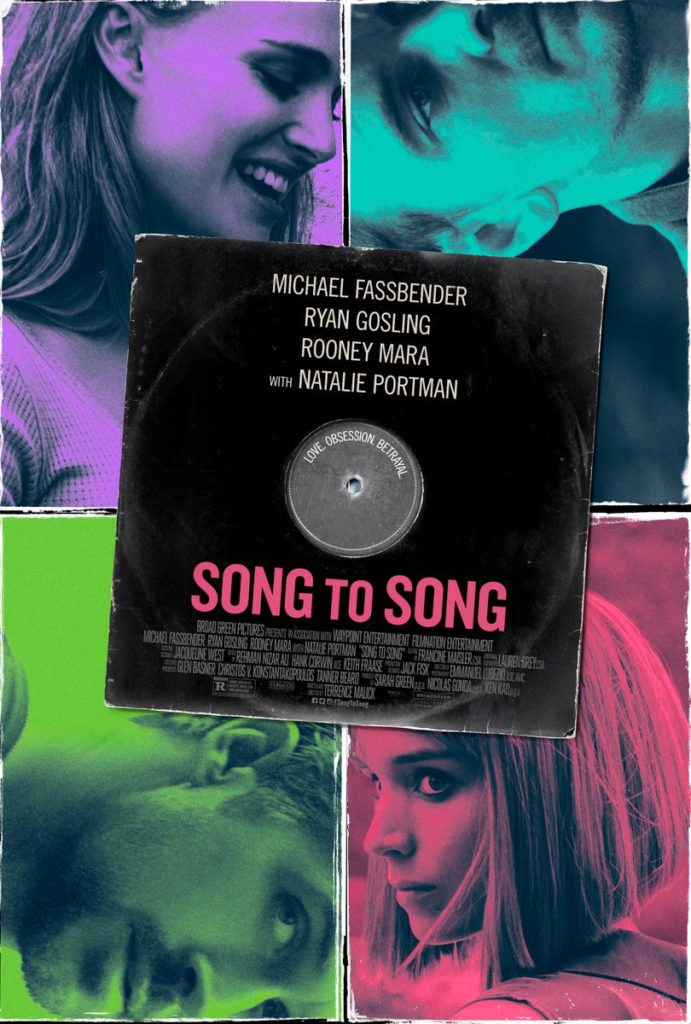If you haven’t had a two-hour long existential crisis lately, get to the theater and see “Song to Song.” Like the typical Terrence Malick film, “Song to Song” gives audiences an elaborate look into the human mind and soul through philosophical lines, symbolism and deliberately mapped out scenes.
Considering the intricacy of the scenes in this film, where the cinematography and dialogue are packed with deep messages, it is no surprise that the filming for the movie started five years ago. But despite the depth of each scene, “Song to Song” fails to deliver new material that we haven’t seen in every preceding Malick film.
“Song to Song” stars Ryan Gosling, Rooney Mara, Michael Fassbender and Natalie Portman, and includes appearances from Cate Blanchett, Val Kimer and Patti Smith. But “Song to Song” is not the expected result of working for years with such a hot and talented cast.
The film is about two couples in Austin, Texas. One couple is made up of Ryan Gosling and Roony Mara, and the other is Michael Fassbender and Natalie Portman. The couples both have ties to Austin’s music scene, as Gosling and Fassbender’s characters are musicians. The characters each have various personal issues that are expressed through voiceover narrations, and their emotions beg to be heard and felt intensely. It is easy to relate to the doubt, personal questioning, and feeling of being lost that is prevalent in these contemplative moments.
“Song to Song” definitely doesn’t disappoint in terms of scenery, nature shots and intimate moments of the captured. The use of natural lighting adds a majestic vibe to the filming. Each individual scene is like a movie in itself, packed full of deep and touching dialogue that intertwines perfectly with the camera angles, the lighting and the movement of the shot.
The problem, though, with every scene being so complex, is that it becomes tiresome and mentally draining to follow the flow of the movie. There isn’t much structure, so the movie goes on and on with dialogue, questioning life and the nature of the human person. There is no continuous timeline, and there is an unreal aspect to many of the scenes. The actors and actresses can often be seen rolling around on the floor, suspended in the air, or in otherwise strange positions. This is indeed interesting and aesthetically pleasing to watch, but it adds to the confusion of figuring out what message the film is trying to convey.
Even the most devoted Malick fans have been struggling to see where he is trying to go with his newest films. His movies up until 2011’s “Tree of Life” all delivered unique and poignant messages and are masterpieces to behold. Then, his movies degenerated into repetitive material that is leaving audiences frustrated. After “Tree Of Life” came “To the Wonder”, “Knight of Cups”, “Voyage of Time”, and now Song to Song, each of which include a lot of meaningful questions that never get answered and a plot build up that fails to ever make a resonating point. Viewers and critics have been losing patience with Malick as his films have mused on the same philosophical questions over and over.
Malick is an advocate of giving the artists he works with creative freedom. He will often film the actors unscripted, allowing them to act as they feel in the moment. This creative freedom and the unique look into the actor or actress themselves is very interesting to see. However, it further adds to the lack of structure and coherence of the film. It is rarely apparent what is going on in the characters’ minds, and sometimes the actions and expressions of the characters seem detached from the words that are being said.
Watching a film by Terrance Malick has always been challenging, especially if you want to take meaning from the film or figure out what it is about. Usually, directors slowly grow into finding a unifying theme and it becomes easier to understand the content of their films and the direction in which they are heading. It is the opposite with Malick. It is becoming harder and harder to understand the meaning of individual movies, let alone overarching themes in his directing. “Song to Song” further supports the growing suspicion that maybe we will never understand Malick, and maybe he doesn’t have a grand plan after all.
Bailee may be reached at
[email protected]












